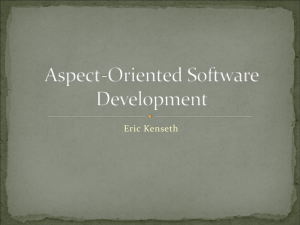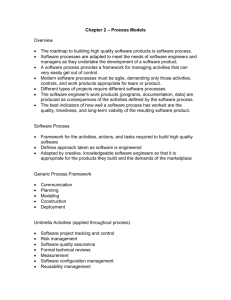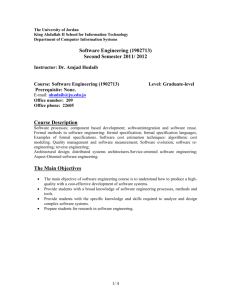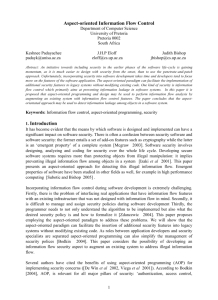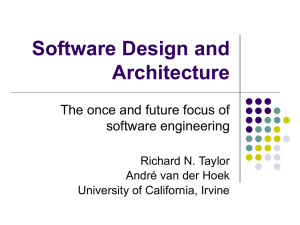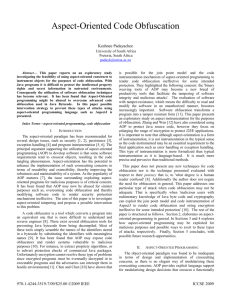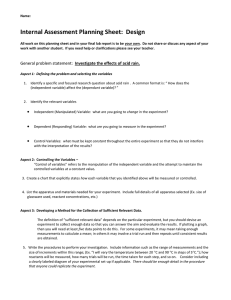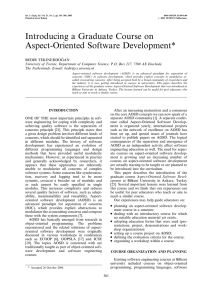PowerPoint Presentation - Project management
advertisement
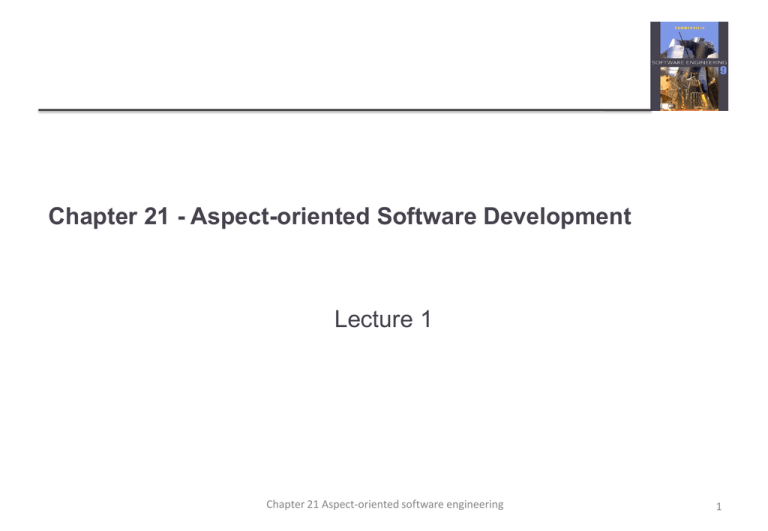
Chapter 21 - Aspect-oriented Software Development
Lecture 1
Chapter 21 Aspect-oriented software engineering
1
Topics covered
The separation of concerns
Aspects, join points and pointcuts
Software engineering with aspects
Chapter 21 Aspect-oriented software engineering
2
Aspect-oriented software development
An approach to software development based around a
relatively new type of abstraction - an aspect.
Used in conjunction with other approaches - normally objectoriented software engineering.
Aspects encapsulate functionality that cross-cuts and coexists with other functionality.
Aspects include a definition of where they should be included
in a program as well as code implementing the cross-cutting
concern.
Chapter 21 Aspect-oriented software engineering
3
The separation of concerns
The principle of separation of concerns states that software
should be organised so that each program element does one
thing and one thing only.
Each program element should therefore be understandable
without reference to other elements.
Program abstractions (subroutines, procedures, objects, etc.)
support the separation of concerns.
Chapter 21 Aspect-oriented software engineering
4
Concerns
Concerns are not program issues but reflect the system
requirements and the priorities of the system stakeholders.
Examples of concerns are performance, security, specific functionality,
etc.
By reflecting the separation of concerns in a program, there is
clear traceability from requirements to implementation.
Core concerns are the functional concerns that relate to the
primary purpose of a system; secondary concerns are
functional concerns that reflect non-functional and QoS
requirements.
Chapter 21 Aspect-oriented software engineering
5
Stakeholder concerns
Functional concerns which are related to specific functionality to be
included in a system.
Quality of service concerns which are related to the non-functional
behaviour of a system.
Policy concerns which are related to the overall policies that govern
the use of the system.
System concerns which are related to attributes of the system as a
whole such as its maintainability or its configurability.
Organisational concerns which are related to organisational goals and
priorities such as producing a system within budget, making use of
existing software assets or maintaining the reputation of an
organisation.
Chapter 21 Aspect-oriented software engineering
6
Cross-cutting concerns
Cross-cutting concerns are concerns whose implementation
cuts across a number of program components.
This results in problems when changes to the concern have to
be made - the code to be changed is not localised but is in
different places across the system.
Cross cutting concerns lead to tangling and scattering.
Chapter 21 Aspect-oriented software engineering
7
Cross-cutting concerns
Chapter 21 Aspect-oriented software engineering
8
Tangling of buffer management and synchronization
code
synchronized void put (SensorRecord rec )
{
// Check that there is space in the buffer; wait if not
if ( numberOfEntries == bufsize)
wait () ;
// Add record at end of buffer
store [back] = new SensorRecord (rec.sensorId,
rec.sensorVal) ;
back = back + 1 ;
// If at end of buffer, next entry is at the beginning
if (back == bufsize)
back = 0 ;
numberOfEntries = numberOfEntries + 1 ;
// indicate that buffer is available
notify () ;
} // put
Chapter 21 Aspect-oriented software engineering
9
Scattering of methods implementing secondary
concerns
Chapter 21 Aspect-oriented software engineering
10
Aspects, join points and pointcuts
An aspect is an abstraction which implements a concern. It
includes information where it should be included in a program.
A join point is a place in a program where an aspect may be
included (woven).
A pointcut defines where (at which join points) the aspect will
be included in the program.
Chapter 21 Aspect-oriented software engineering
11
Terminology used in aspect-oriented software
engineering
Term
Definition
advice
The code implementing a concern.
aspect
A program abstraction that defines a cross-cutting
concern. It includes the definition of a pointcut and the
advice associated with that concern.
An event in an executing program where the advice
associated with an aspect may be executed.
The set of events that may be referenced in a pointcut.
join point
join point model
pointcut
weaving
A statement, included in an aspect, that defines the join
points where the associated aspect advice should be
executed.
The incorporation of advice code at the specified join
points by an aspect weaver.
Chapter 21 Aspect-oriented software engineering
12
An authentication aspect
aspect authentication
{
before: call (public void update* (..)) // this is a pointcut
{
// this is the advice that should be executed when woven into
// the executing system
int tries = 0 ;
string userPassword = Password.Get ( tries ) ;
while (tries < 3 && userPassword != thisUser.password ( ) )
{
// allow 3 tries to get the password right
tries = tries + 1 ;
userPassword = Password.Get ( tries ) ;
}
if (userPassword != thisUser.password ( )) then
//if password wrong, assume user has forgotten to logout
System.Logout (thisUser.uid) ;
}
} // authentication
Chapter 21 Aspect-oriented software engineering
13
AspectJ - join point model
Call events
Calls to a method or constructor
Execution events
Execution of a method or constructor
Initialisation events
Class or object initialisation
Data events
Accessing or updating a field
Exception events
The handling of an exception
Chapter 21 Aspect-oriented software engineering
14
Pointcuts
Identifies the specific events with which advice should be
associated.
Examples of contexts where advice can be woven into a
program
Before the execution of a specific method
After the normal or exceptional return from a method
When a field in an object is modified
Chapter 21 Aspect-oriented software engineering
15
Aspect weaving
Aspect weavers process source code and weave the aspects
into the program at the specified pointcuts.
Three approaches to aspect weaving
Source code pre-processing
Link-time weaving
Dynamic, execution-time weaving
Chapter 21 Aspect-oriented software engineering
16
Aspect weaving
Chapter 21 Aspect-oriented software engineering
17
Software engineering with aspects
Aspects were introduced as a programming concept but, as
the notion of concerns comes from requirements, an aspect
oriented approach can be adopted at all stages in the system
development process.
The architecture of an aspect-oriented system is based
around a core system plus extensions.
The core system implements the primary concerns.
Extensions implement secondary and cross-cutting concerns.
Chapter 21 Aspect-oriented software engineering
18
Core system with extensions
Chapter 21 Aspect-oriented software engineering
19
Types of extension
Secondary functional extensions
Add extra functional capabilities to the core system
Policy extensions
Add functional capabilities to support an organisational policy such as
security
QoS extensions
Add functional capabilities to help attain quality of service requirements
Infrastructure extensions
Add functional capabilities to support the implementation of the system
on some platform
Chapter 21 Aspect-oriented software engineering
20
Key points
Aspect-oriented approach to software development supports the
separation of concerns. By representing cross-cutting concerns as
aspects, individual concerns can be understood, reused and modified
without changing other parts of the program.
Tangling occurs when a module in a system includes code that
implements different system requirements. Scattering occurs when the
implementation of a concern is scattered across several components.
Aspects include a pointcut that defines where the aspect will be woven
into the program, and advice – the code to implement the cross-cutting
concern. Join points are events that can be referenced in a pointcut.
To ensure the separation of concerns, systems can be designed as a core
system that implements the primary concerns of stakeholders, and a set of
extensions that implement secondary concerns.
Chapter 21 Aspect-oriented software engineering
21
Chapter 21 - Aspect-oriented Software Development
Lecture 2
Chapter 21 Aspect-oriented software engineering
22
Concern-oriented requirements engineering
An approach to requirements engineering that focuses on
customer concerns is consistent with aspect-oriented
software development.
Viewpoints are a way to separate the concerns of different
stakeholders.
Viewpoints represent the requirements of related groups of
stakeholders.
Cross-cutting concerns are concerns that are identified by all
viewpoints.
Chapter 21 Aspect-oriented software engineering
23
Viewpoints and Concerns
Chapter 21 Aspect-oriented software engineering
24
Viewpoints on an equipment inventory system
1. Emergency service users
1.1
Find a specified type of equipment (e.g., heavy lifting gear)
1.2
View equipment available in a specified store
1.3
Check-out equipment
1.4
Check-in equipment
1.5
Arrange equipment to be transported to emergency
1.6
Submit damage report
1.7
Find store close to emergency
2. Emergency planners
2.1
Find a specified type of equipment
2.2
View equipment available in a specified location
2.3
Check-in/cCheck out equipment from a store
2.4
Move equipment from one store to another
2.6
Order new equipment
Chapter 21 Aspect-oriented software engineering
25
Viewpoints on an equipment inventory system
3. Maintenance staff
3.1
Check -in/cCheck -out equipment for maintenance
3.2
View equipment available at each store
3.3
Find a specified type of equipment
3.4
View maintenance schedule for an equipment item
3.5
Complete maintenance record for an equipment item
3.6
Show all items in a store requiring maintenance
Chapter 21 Aspect-oriented software engineering
26
Availability-related requirements for the equipment
inventory system
AV.1
There shall be a ‘hot standby’ system available in a location that is
geographically well-separated from the principal system.
Rationale: The emergency may affect the principal location of the system.
AV.1.1
All transactions shall be logged at the site of the principal system and
at the remote standby site.
Rationale: This allows these transactions to be replayed and the system
databases made consistent.
AV.1.2
The system shall send status information to the emergency control
room system every five minutes.
Rationale: The operators of the control room system can switch to the hot
standby if the principal system is unavailable.
Chapter 21 Aspect-oriented software engineering
27
Inventory system - core requirements
C.1 The system shall allow authorised users to view the
description of any item of equipment in the emergency
services inventory.
C.2 The system shall include a search facility to allow
authorised users to search either individual inventories or the
complete inventory for a specific item or type of equipment.
Chapter 21 Aspect-oriented software engineering
28
Inventory system - extension requirements
E1.1 It shall be possible for authorised users to place orders
with accredited suppliers for replacement items of equipment.
E1.1.1 When an item of equipment is ordered, it should be
allocated to a specific inventory and flagged in that inventory
as ‘on order’.
Chapter 21 Aspect-oriented software engineering
29
Aspect-oriented design/programming
Aspect-oriented design
The process of designing a system that makes use of aspects to
implement the cross-cutting concerns and extensions that are
identified during the requirements engineering process.
Aspect-oriented programming
The implementation of an aspect-oriented design using an aspectoriented programming language such as AspectJ.
Chapter 21 Aspect-oriented software engineering
30
Use-cases
A use-case approach can serve as a basis for aspect-oriented
software engineering.
Each use case represents an aspect.
Extension use cases naturally fit the core + extensions architectural
model of a system
Jacobsen and Ng develop these ideas of using use-cases by
introducing new concepts such as use-case slices and use
case modules.
Chapter 21 Aspect-oriented software engineering
31
Use cases from the inventory management system
Chapter 21 Aspect-oriented software engineering
32
Extension use cases
Chapter 21 Aspect-oriented software engineering
33
A generic aspect-oriented design process
Chapter 21 Aspect-oriented software engineering
34
Design activities
Core system design where you design the system
architecture to support the core functionality of the system.
Aspect identification and design Starting with the extensions
identified in the system requirements, you should analyze
these to see if they are aspects in themselves or if they
should be broken down into several aspects.
Composition design At this stage, you analyze the core
system and aspect designs to discover where the aspects
should be composed with the core system. Essentially, you
are identifying the join points in a program at which aspects
will be woven.
Chapter 21 Aspect-oriented software engineering
35
Design activities
Conflict analysis and resolution Conflicts occur when there is
a pointcut clash with different aspects specifying that they
should be composed at the same point in the program.
Name design is essential to avoid the problem of accidental
pointcuts. These occur when, at some program join point, the
name accidentally matches that in a pointcut pattern. The
advice is therefore unintentionally applied at that point.
Chapter 21 Aspect-oriented software engineering
36
UML extensions
Expressing an aspect oriented design in the UML requires:
A means of modelling aspects using UML stereotypes.
A means of specifying the join points where the aspect advice is to be
composed with the core system.
Chapter 21 Aspect-oriented software engineering
37
An aspect-oriented design model
Chapter 21 Aspect-oriented software engineering
38
Part of a model of an aspect
Chapter 21 Aspect-oriented software engineering
39
Extension statement
In the method viewItem, after the call to the method
getItemInfo, a call to the method displayHistory should be
included to display the maintenance record
Chapter 21 Aspect-oriented software engineering
40
Verification and validation
The process of demonstrating that a program meets it
specification (verification) and meets the real needs of its
stakeholders (validation)
Like any other systems,aspect-oriented systems can be
tested as black-boxes using the specification to derive the
tests
However, program inspections and ‘white-box’ testing that
relies on the program source code is problematic.
Aspects also introduce additional testing problems
Chapter 21 Aspect-oriented software engineering
41
Program inspection problems
To inspect a program (in a conventional language) effectively,
you should be able to read it from right to left and top to
bottom.
Aspects make this impossible as the program is a web rather
than a sequential document. You can’t tell from the source
code where an aspect will be woven and executed.
Flattening an aspect-oriented program for reading is
practically impossible.
Chapter 21 Aspect-oriented software engineering
42
White box testing
The aim of white box testing is to use source code knowledge
to design tests that provide some level of program coverage
e.g. each logical branch in a program should be executed at
least once.
Aspect problems
How can source code knowledge be used to derive tests?
What exactly does test coverage mean?
Chapter 21 Aspect-oriented software engineering
43
Aspect problems
Deriving a program flow graph of a program with aspects is
impossible. It is therefore difficult to design tests
systematically that ensure that all combinations of base code
and aspects are executed.
What does test coverage mean?
Code of each aspect executed once?
Code of each aspect exeucted once at each join point where aspect
woven?
???
Chapter 21 Aspect-oriented software engineering
44
Testing problems with aspects
How should aspects be specified so that tests can be
derived?
How can aspects be tested independently of the base
system?
How can aspect interference be tested?
How can tests be designed so that all join points are executed
and appropriate aspect tests applied?
Chapter 21 Aspect-oriented software engineering
45
Key points
To identify concerns, you may use a viewpoint-oriented
approach to requirements engineering to elicit stakeholder
requirements and to identify cross-cutting quality of service
and policy concerns.
The transition from requirements to design can be made by
identifying use cases, where each use case represents a
stakeholder concern.
The problems of inspecting and deriving tests for aspectoriented programs are a significant barrier to the adoption of
aspect-oriented software development in large software
projects.
Chapter 21 Aspect-oriented software engineering
46
